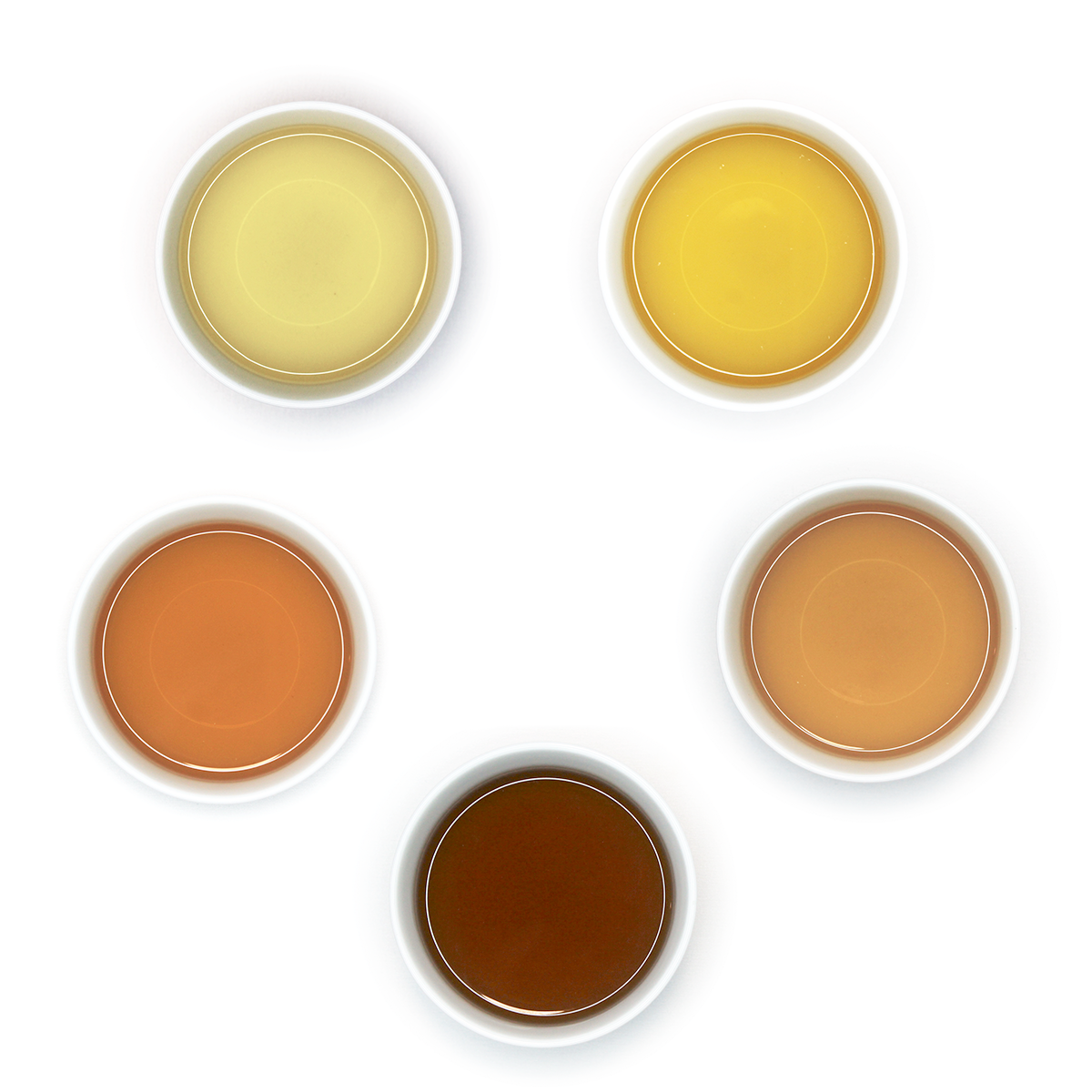
The Six Types of Tea
A frequent question we get is about what makes tea, tea. While we often refer infusions in general as tea, all teas actually come from the same plant, Camellia Sinensis. Herbal teas are not considered teas under this definition, but rather we call them tisanes or herbal infusions.
From here, we can break tea down into six categories: white, black, yellow, green, oolong, and puerh. So, what's the difference between these types of tea?
Teas are broken down by the processing method that is used. For white, black, green and oolong teas, they can also be categorized by their oxidation level.
White
White tea is typically considered the most delicate tea variety because it is very minimally processed. White teas are typically only withered and dried, with no additional processing like rolling, steaming, or firing. This limited processing results in a very lightly oxidized tea with a soft, sweet flavor.
Bai Hao Yin Zhen, or silver needle, is one of the most popular white teas. This tea consists of only the young buds of the camellia sinensis plant. The buds are covered in fluffy down and the resulting brews typically have a very sweet and floral flavor.
Black

On the opposite end of the spectrum from white tea, black tea is fully oxidized and undergoes much more thorough processing. Black teas are the most consumed type of tea around the world, often drunk with milk and sugar.
Black tea is also referred to as red tea and has a strong, rich flavor. The brew typically has a dark, red, coppery color, hence commonly being referred to as red tea. These teas are primarily produced in China, India, and Kenya, with a huge amount of variant in flavor, processing method, and even appearance coming from each country.
One of our favorite black teas: Golden Monkey
Yellow
Similar to white tea, yellow teas are very lightly oxidized. However, instead of being immediately dried, the tea is encased and left to rest in the heat and humidity. This gives the leaves their characteristic yellow hue. This step also produces a more mellow flavor than you typically find in a green tea. Yellow teas are increasingly rare and expensive as the process is labor intensive, time consuming, and requires great skill to produce.
Green
Green teas have a similar level of oxidation to yellow and white teas. They undergo a withering step, also called fixing green, which prevents oxidation. The method used produces a distinct flavor, often associated with the country it's made in. In China, pan frying, roasting, and smoking are commonly used to produce green teas, which results in a smokier and nuttier flavor. On the other end of the spectrum, Japanese green teas are usually processed by steaming. This produces a grassier, almost marine-like flavor.
Different regions often have different shaping styles as well. Long Jing for example are buds that are pressed into long, flat needles. Whereas Bi Lo Chun leaves are rolled.
Matcha is another type of green tea. Matcha is made by grinding green tea leaves into a powder. The tea is usually grown in the shade and then steamed, producing a strong, grassy flavor.
Oolong

Oolong teas are partially oxidized teas and this category is somewhere between a green tea and a black tea. These teas can have fruity, floral, and toasty notes, with a huge range of flavors, appearance, and aroma. The cultivars and terroirs of oolong teas have a very big influence on the resulting flavor. This category of tea is easily the most varied.
Some oolongs are rolled into tight balls that expand when brewed, while others are left as long, spindly leaves. Some of the highest quality oolongs come from China and Taiwan, with Taiwan in particular being famous for oolongs. Some of our oolong teas come from Thailand, which produce oolongs in the Taiwanese style. Our Jin Xuan Oolong is a great example of the highly sought after Taiwanese style of oolongs.
Scented and roasted oolongs are also very popular. These production methods introduce another range of flavors to the already varied oolong category. Our magnolia oolong is one of our favorite examples of a scented oolong.
Puerh
Puerh teas are very different from the other 5 categories of tea. Puerh, also referred to as dark tea, is a fermented tea. Typically, the leaves are fermented and pressed into bricks, cakes, or other shapes, although some puerhs are left as loose leaf teas. These teas traditionally come from Yunnan Province, China. These teas have a strong, earthy flavor, that may even be described as barnyard-like. Some puerhs have a rich, sweet, fruity flavor that pairs beautifully with the characteristic earthy notes of puerh teas.
Puerh teas come in 2 styles, raw, Sheng, puerh and ripe, Shou, puerh. Sheng puerhs are naturally fermented and their flavor develops and matures over time into a rich and complex flavor. Shou puerhs undergo an accelerated fermentation process. This method is still relatively new and has made puerh far more accessible, especially in western countries, as Sheng puerhs can often come with a hefty price tag, especially if purchased as a whole cake.
Our Premium Wild Tree Raw Puerh is an exceptional loose leaf puerh and the Gong Ting Puerh Touches are a perfect way to try a high quality puerh without the hefty price tag.
